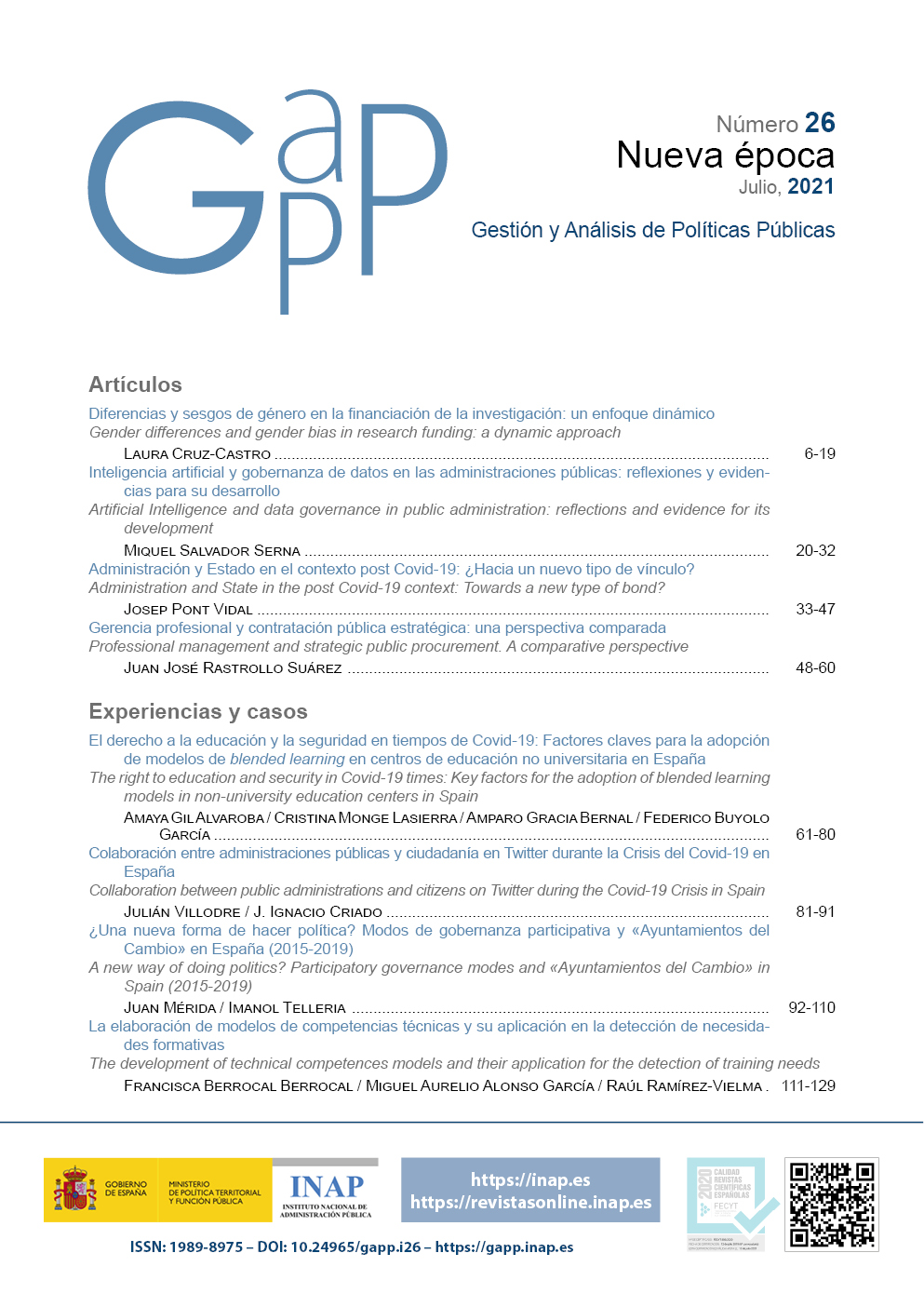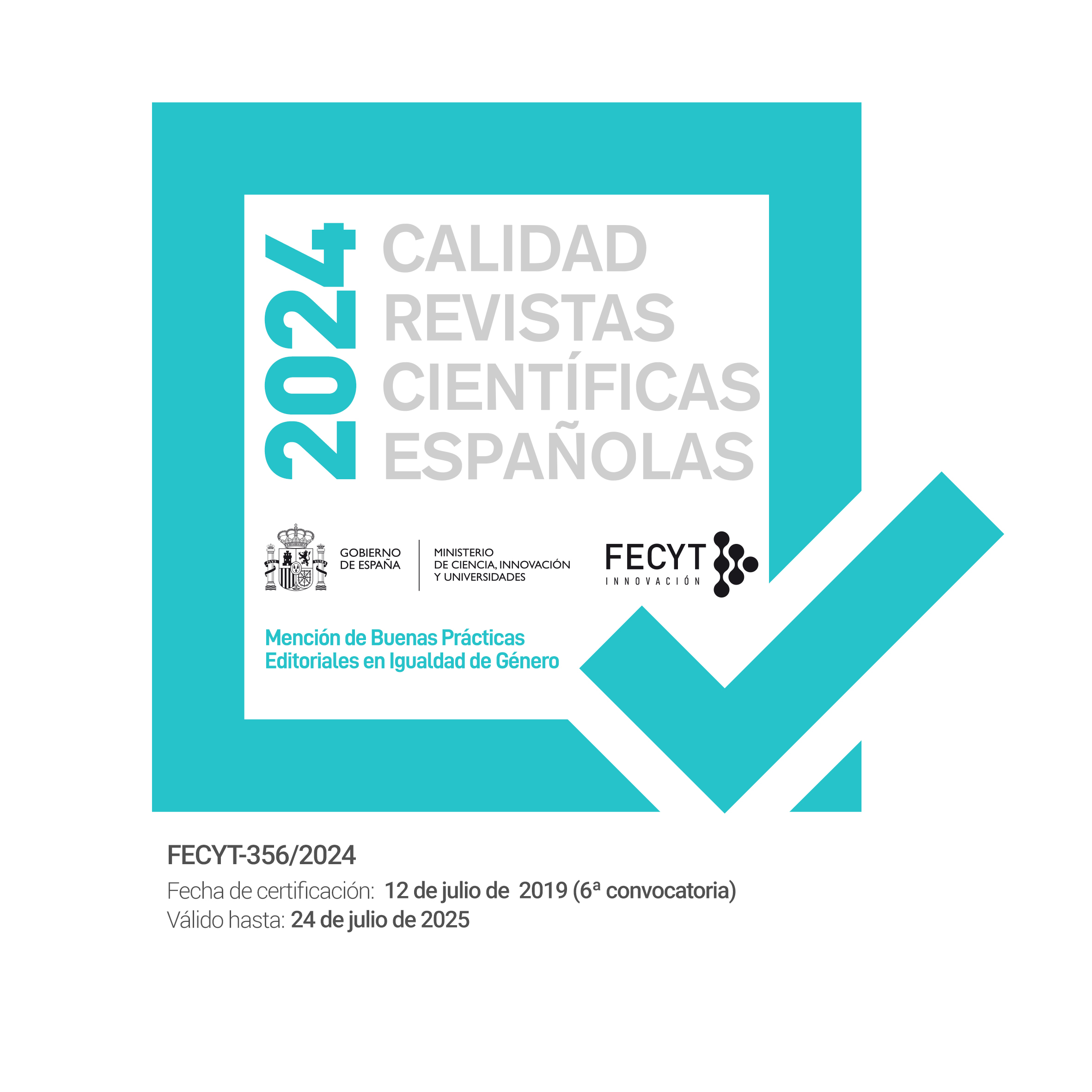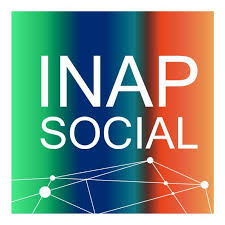The development of technical competences models and their application for the detection of training needs
DOI:
https://doi.org/10.24965/gapp.i26.10813Keywords:
Technical competencies, competency models, training needs, human resources, functional analysisAbstract
Identification of technical Competencies required in different functional areas, by professional levels, allows selection and training processes to be addressed in a more effective and efficient way, contributing to the added value of the actions developed by the National Institute of Public Administration (INAP) and achieving the General State Administration (AGE) objectives. The objective of this paper are to propose a methodology to identify and define the technical competencies needed for a correct work performance, as well as to contrast its usefulness in detecting training needs for AGE workers. The methodology uses both focus groups for the making of profiles in the area of people management and questionnaires to detect learning needs. Application process of the functional analysis carried out and the results obtained are described. Specifically, the model of technical competencies in the area of people management for managerial, technical and support roles, and the training needs study results carried out in the area. Implications of the process are discussed, and improvement suggestions for the detection of training needs and training planning within the AGE are formulated.
Downloads
References
Albino, G. (2018). Technical and behavioral competencies on performance evaluation: Petrek leaders’ perspectives. SAGE Open, 8(2). https://doi.org/10.1177/2158244018780972
Basoredo Ledo, C. (2008). Diseño de currículos de formación a partir de tareas y por competencias [Tesis doctoral inédita]. Universidad de Deusto.
Blanco Prieto, A. (2007). Trabajadores competentes: introducción y reflexiones sobre la gestión de recursos humanos por competencias. ESIC.
Bonder, A., Bouchard, C.-D. y Bellemare, G. (2011). Competency-based management. An integrated approach to human resource management in the canadian public sector. Public Personnel Management, 40(1), 1-10. https://doi.org/10.1177/009102601104000101
Boyatzis, R. E. (1982). The competent manager: a model for effective performance. John Wiley & Sons.
Campion, M. A., Fink, A. A., Ruggeberg, B. J., Carr, L., Phillips, G. M. y Odman, R. B. (2011). Doing competencies well: best practices in competency modeling. Personnel Psychology, 64(1), 225-262. https://doi.org/10.1111/j.1744-6570.2010.01207.x
Carroll, G. y Boutall, T. (2011). Guide to developing national occupational standards. UK Commission for Employment and Skills. https://assets.publishing.service.gov.uk/government/uploads/system/uploads/attachment_data/file/304239/nos-guide-for-_developers-2011.pdf
ChileValora y OIT (2012). Guía de apoyo para la elaboración del análisis funcional. Centro Interamericano para el Desarrollo del Conocimiento en la Formación Profesional. Cinterfor/OIT. https://www.oitcinterfor.org/sites/default/files/certificacion/ChileValora_GuiaApoyoAnalisisFuncional.pdf
Consejo de Normalización y Certificación de Competencia Laboral – CONOCER (1998). Análisis ocupacional y funcional del trabajo. Organización de Estados Iberoamericanos para la Educación, la Ciencia y la Cultura – OEI.
Consejo de Normalización y Certificación de Competencia Laboral – CONOCER (s. f.). Guía técnica para la elaboración del Mapa Funcional. Sistema normalizado de competencia laboral. Organización de Estados Americanos. http://www.oas.org/udse/cd_trabajo/ingles/9-Gu%EDa%20mapa%20funcional.pdf
Dalziel, M., Cubeiro, J. y Fernández, G. (1996). Las competencias: clave para una gestión integrada de los recursos humanos. Deusto.
Fine, S. A. (1988). Functional job analysis. En S. Gael (ed.), The job analysis handbook for business, industry and government. John Wiley & Sons.
Feltovich, P. J., Spiro, R. J. y Coulson, R. L. (1997). Issues of expert flexibility in contexts characterised by complexity and change. En P. J. Feltovich, K. M. Ford y R. R. Hoffman (eds.), Expertise in context: human and machine (pp. 125-146). MIT Press.
Fletcher, S. (1997). Analysing competence: tools and techniques for analysing jobs, roles and functions. Kogan Page Publishers.
Galleli, B., Hourneaux Jr, F. y Munck, L. (2019). Sustainability and human competences: a systematic literature review. Benchmarking: An International Journal, 27(7), 1981-2004. https://doi.org/10.1108/BIJ-12-2018-0433
Getha-taylor, H., Blackmar, J. y Borry, E. L. (2016). Are competencies universal or situational? A state-level investigation of collaborative competencies. Review of Public Personnel Administration, 36(3), 306-320. https://doi.org/10.1177/0734371X15624132
Gorriti Bontigui, M. y López Basterra, J. (2010). Análisis de puestos de trabajo en la Administración Pública. Instituto Vasco de Administraciones Públicas – IVAP.
Hesketh, B. y Neal, A. (1999). Technology and performance. En D. R. Ilgen y E. D. Pulakos (eds.), The changing nature of performance: implications for staffing, motivation and development (pp. 21-55). Jossey-Bass.
Hogg, B. (1993). European Managerial Competencies. European Business Review, 93(2), 21-26.
Instituto Andaluz de Administración Pública (2015). Diccionario de competencias técnicas de la Administración General de la Junta de Andalucía. Junta de Andalucía.
Jackson, D. (2009). Profiling industry-relevant management graduate competencies: the need for a fresh approach. International Journal of Management Education, 8(1), 85-98.
Kopnov, V. A., Shmurygina, O. V., Shchipanova, D. E., Dremina M. A., Papaloizou L., Orphanidou, Y. y Morevs, P. (2018). Functional analysis and functional maps of qualifications in ECVET context. The Education and Science Journal, 20(6), 90-117. https://doi.org/10.17853/1994-5639-2018-6-90-117
Le Boterf, G. (2001). Ingeniería de las competencias. Gestión 2000.
Lévy-Leboyer, C. (1997). Gestión de las competencias: cómo analizarlas, cómo evaluarlas, cómo desarrollarlas. Gestión 2000.
Macchi Silva, V. V., Ribeiro, J. L. D., Álvarez, G. R. y Caregnato, S. E. (2019). Competence-based management research in the web of science and scopus databases: scientific production, collaboration and impact. Publications, 7(4), 60. https://doi.org/10.3390/publications7040060
Mansfield, R. y Mitchell, L. (1996). Towards a competent workforce. Gower.
Markus, L. H., Cooper-Thomas, H. D. y Allpress, K. N. (2005). Confounded by competencies? An evaluation of the evolution and use of competency models. New Zealand Journal of Psychology, 34(2), 117-126.
Megahed, N. (2018). A Critical review of the literature and practice of competency modelling. Sustainability and Resilience Conference: Mitigating Risks and Emergency Planning. KnE Social Sciences, 3(10), 104-126. https://doi.org/10.18502/kss.v3i10.3106
Mertens, L. (1997). Competencia laboral: sistemas, surgimientos y modelos. Centro Interamericano para el Desarrollo del Conocimiento en la Formación Profesional – CINTERFOR/OIT.
Pereda, S. y Berrocal, F. (2011). Dirección y gestión de recursos humanos por competencias. Editorial Universitaria Ramón Areces.
Potnuru, R. K. G. y Sahoo, C. K. (2016). HRD interventions, employee competencies and organizational effectiveness: an empirical study. European Journal of Training and Development, 40(5), 345-365. https://doi.org/10.1108/ejtd-02-2016-0008
Pujol, J. (1980). Análisis ocupacional. Manual de aplicación para instituciones de formación. Centro Interamericano para el Desarrollo del Conocimiento en la Formación Profesional – Cinterfor/OIT.
Ramírez-Díaz, J. (2020). An approach by competencies and its current relevance: considerations from occupational guidance in educational context. Revista Electrónica Educare, 24(2). https://doi.org/10.15359/ree.24-2.23
Salman, M., Ganie, S. A. y Saleem, I. (2020). The concept of competence: a thematic review and discussion. European Journal of Training and Development, 44(6/7), 717-742. https://doi.org/10.1108/EJTD-10-2019-0171
Spencer, L. M. y Spencer, S. M. (1993). Competence at work models for superior performance. John Wiley & Sons.
Downloads
Published
How to Cite
Issue
Section
License
Copyright (c) 2021 Gestión y Análisis de Políticas Públicas

This work is licensed under a Creative Commons Attribution-NonCommercial 4.0 International License.












